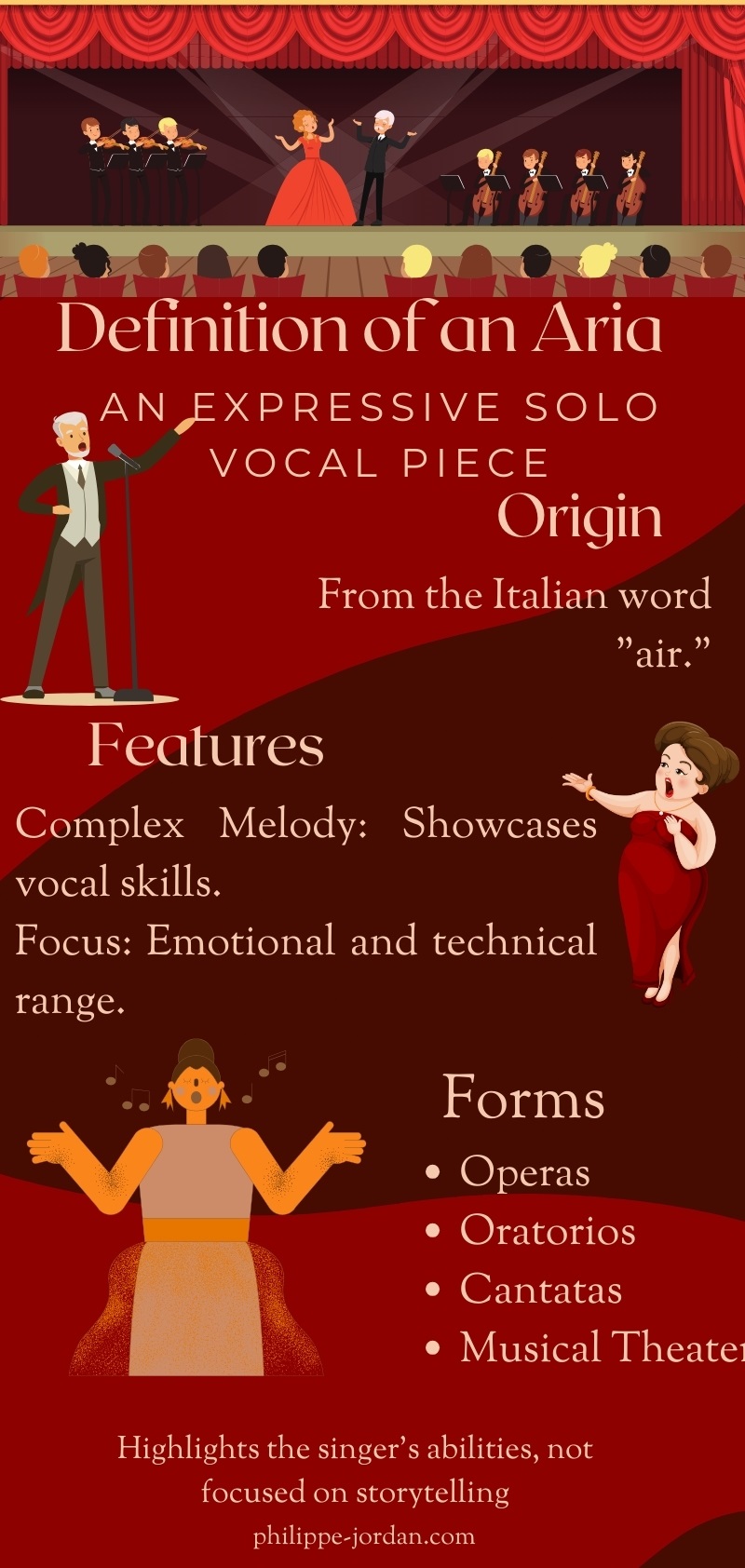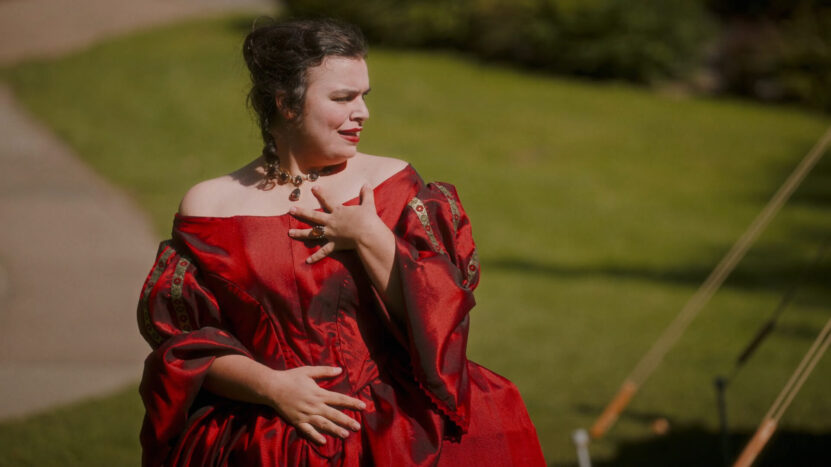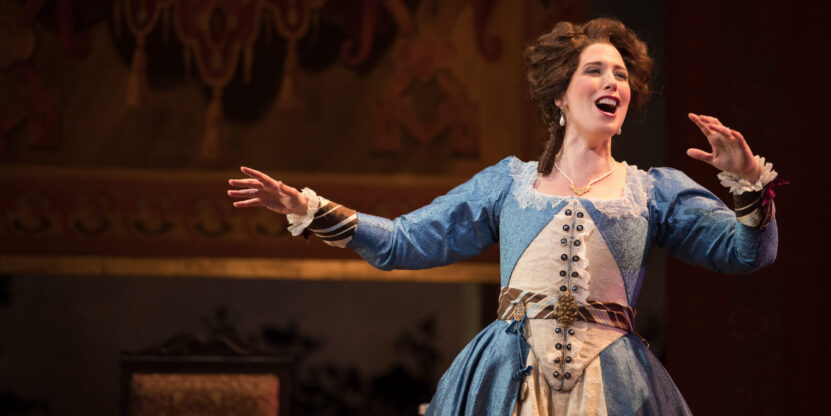An aria is a solo vocal composition typically found in operas, oratorios, cantatas, and musical theater. The term “aria” has its roots in Italian, where it simply means “air” or “melody.”
Aria has been a significant part of classical music for centuries, serving as a key element in various musical works.
It is characterized by its expressive and often elaborate style, allowing singers to showcase their vocal prowess.
Definition of an Aria

An aria is a solo vocal piece that stands out for its expressive and elaborate nature.
Originating from the Italian word for “air,” an aria typically features a complex melody designed to highlight the singer’s vocal skills.
Aria can be found in various forms of classical music, including:
- Operas
- Oratorios
- Cantatas
- Musical theater
Unlike other vocal pieces that may prioritize storytelling or dialogue, an aria focuses on showcasing the singer’s emotional and technical range.
Comparison with Other Musical Forms
Arias are distinct from other vocal forms like art songs, recitatives, and airs in several key ways.
These differences are evident in their structure, purpose, and performance style, making each of them unique.
Art Songs
Typically stand-alone pieces, art songs are often more suitable for younger or beginning singers due to their simpler structure and manageable length.
Art songs emphasize the intimate relationship between voice and piano, usually setting poetry to music in a way that highlights the text’s meaning and emotion.
Unlike arias, which are part of larger works like operas and are usually accompanied by an orchestra, art songs are performed in recitals and are known for their more modest, yet deeply expressive, nature.
Composers like Franz Schubert and Robert Schumann are well-known for their contributions to this genre, creating works that are both accessible and artistically profound.
Recitatives
Serving a dramatic and narrative function in operas, recitatives mimic speech patterns and are used to advance the plot.
They are usually less melodic and more rhythmically free compared to arias. Recitatives are designed to convey dialogue and action quickly, often preceding an aria that goes into a character’s emotions.
There are two main types:
- Secco (dry) recitatives, accompanied only by a basso continuo
- Accompagnato (or stromentato) recitatives, involve more elaborate orchestral accompaniment.
The primary focus of recitatives is on clear and direct communication of the storyline, making them a vital part of the operatic structure.
Airs (or Ayres)
Early English art songs, airs, or ayres, combine poetry with simple melodies, often accompanied by lute or other early instruments.
These songs flourished during the Renaissance and Baroque periods and were a staple of English courtly and theatrical music.
Composers like John Dowland and Thomas Campion were renowned for their airs, which prioritized clear text setting and accessible melodies over the virtuosic demands found in arias.
Unlike the elaborate and expressive nature of arias, airs focus on lyrical simplicity and straightforward musical expression, making them charming and elegant in their own right.
Characteristics of an Aria
An aria is typically a solo vocal composition that can be accompanied by an orchestra or individual instruments.
The primary characteristic of an aria is its focus on expressing emotion and showcasing the singer’s vocal abilities.
In operas, oratorios, and cantatas, arias are essential for adding emotional depth and character insight.
The accompaniment varies from simple continuo in early music to full orchestral arrangements in later works.
The structure of an aria often includes repeated sections or variations, allowing the singer to demonstrate technical prowess and interpretative skills.
Types of Arias
Arias come in various forms, each with its unique structure and style. Here are some of the major types:
| Type of Aria | Description | Characteristics |
|---|---|---|
| Da Capo Aria | Follows ternary form (ABA); initial section repeated with embellishments. | Baroque era; allows creativity and skill display. |
| Strophic Aria | Same music repeated for each verse (AAA). Emphasizes lyrical content. | Early opera; straightforward and moving. |
| Arietta | Shorter, concise version of an aria. | Quick emotional interlude; less development. |
| Aria Buffa | Comic aria with humorous themes and playful melodies. | Lighthearted; designed to entertain. |
| Aria Parlante | Mimics speech rhythms, less melodic, focuses on text expression. | Speech-like; serves dramatic and narrative function. |
| Aria di Bravura | Virtuosic aria with rapid runs, high notes, and ornamentation. | Demanding; highlights technical skill. |
| Cabaletta | Fast, concluding section following a slower cantabile section. | Dynamic; builds excitement; common in bel canto operas. |
| Concert Aria | Stand-alone piece for concert performance. | Showcases vocal prowess; performed in concerts. |
Role of Arias in Opera

In operas, arias play a crucial role in providing emotional depth and character insight.
They serve as moments where characters can express their innermost thoughts and feelings, often in a more reflective and personal manner than in the surrounding action.
Arias is also a showcase for vocal virtuosity, allowing singers to display their technical and expressive abilities.
Structurally, they can act as pivotal points within an opera, highlighting significant emotional or dramatic moments.

